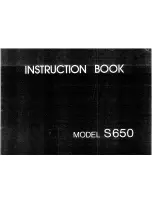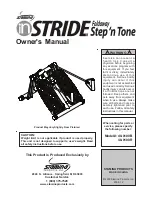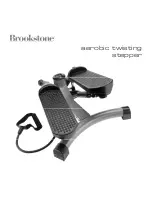
units. Here, the internal equalizer circuit reduces the image signals
to a long-distance receiving level.
This is designed to correct the characteristics of the frequency
band centered around 3 kHz and maintain a constant receiving
sensitivity.
It can be set in the service mode.
Refer to
2.3.7.1. CHECK SHEET
().
3. DTMF Transmission (Monitor tone)
The DTMF signal generated in the modem (IC505) is output from
pin 44, and the NCU section to the telephone line the same as
facsimile transmission signals.
(DTMF Monitor Tone)
Refer to
2.3.7.1. CHECK SHEET
().
4. Busy/Dial Tone Detection
The path is the same as FAX receiving. When it is detected, the
carrier detect bit of the resistor in the modem (IC505) becomes 1,
and this status is monitored by ASIC (IC501).
6.7. DESCRIPTION OF BLOCK DIAGRAM IN ANALOG SECTION
1. Function
The analog section serves as an interface between the telephone
line. The digital board (IC505) for transmission and reception of
FAX signals, switches between the digital board (IC505) and other
sections by means of a multiplexer in the NCU section. The control
signals to the individual analog sections are output mainly from
ASIC IC501, and the status information for the various sections is
also held in ASIC IC501. / Simple explanations for the various
sections are given below.
2. Circuit Operation
[NCU Section]
This is the interface between the telephone line and external telephone. This is composed of a
bell detection circuit, pulse dial generation circuit, EXT. TAM OFF-HOOK detect circuit, vox
circuit, amplifier circuit for line transmission and reception, sidetone circuit, etc. /
[Modem (IC505)]
This is used for FAX signal tone modulation, DTMF signal transmission, ring tone generation, and
187
Summary of Contents for KX-FP80C
Page 9: ...1 10 OPTIONAL ACCESSORIES 1 11 TEST CHART 1 11 1 ITU T No 1 TEST CHART 9 ...
Page 10: ...1 11 2 ITU T No 2 TEST CHART 10 ...
Page 11: ...1 12 LOCATION OF CONTROLS 1 12 1 OVERVIEW 11 ...
Page 24: ...2 Push the back cover open button and open the back cover 24 ...
Page 30: ...1 15 2 1 MAINTENANCE LIST 30 ...
Page 38: ...Note Do not pull out the jammed paper forcibly before opening the front cover 38 ...
Page 40: ...2 Push the back cover open button and open the back cover 40 ...
Page 56: ...Fig C 2 3 4 12 ABLANK PAGE IS RECEIVED 56 ...
Page 71: ...71 ...
Page 72: ...CROSS REFERENCE 2 5 TEST FUNCTIONS 72 ...
Page 73: ...CROSS REFERENCE 2 5 TEST FUNCTIONS 73 ...
Page 74: ...CROSS REFERENCE 2 5 TEST FUNCTIONS 74 ...
Page 75: ...CROSS REFERENCE 2 5 TEST FUNCTIONS 75 ...
Page 76: ...76 ...
Page 77: ...77 ...
Page 78: ...78 ...
Page 90: ...2 3 6 3 CHECK THE STATUS OF THE DIGITAL BOARD 90 ...
Page 93: ...3 No ring tone or No bell CROSS REFERENCE 2 3 7 1 CHECK SHEET 93 ...
Page 96: ...2 3 8 2 TOROUBLESHOOTING FLOW CHART 96 ...
Page 97: ...97 ...
Page 98: ...98 ...
Page 102: ...CROSS REFERENCE 2 5 TEST FUNCTIONS 102 ...
Page 103: ...2 3 12 THERMAL HEAD SECTION Refer to 6 4 3 THERMAL HEAD 103 ...
Page 105: ...2 4 3 USER MODE The list below is an example of the SYSTEM SETUP LIST the unit prints out 105 ...
Page 106: ...Note The above values are the default values 2 4 4 SERVICE FUNCTION TABLE 106 ...
Page 117: ...117 ...
Page 122: ...2 Left margin Top margin Reference pattern 122 ...
Page 123: ...3 Thermal head 1 dot Reference pattern 123 ...
Page 127: ...4 2 HOW TO REMOVE THE OPERATION PANEL BLOCK 127 ...
Page 128: ...4 3 HOW TO REMOVE THE OPERATION BOARD AND LCD 128 ...
Page 129: ...4 4 HOW TO REMOVE THE ANALOG DIGITAL AND POWER BOARDS AND AC INLET 129 ...
Page 130: ...4 5 HOW TO REMOVE THE MOTOR BLOCK 130 ...
Page 131: ...131 ...
Page 132: ...4 6 HOW TO REMOVE THE SEPARATION ROLLER 132 ...
Page 133: ...4 7 HOW TO REMOVE THE IMAGE SENSOR CIS 133 ...
Page 134: ...4 8 HOW TO REMOVE THE TERMAL HEAD 134 ...
Page 135: ...4 9 HOW TO REMOVE THE PLATEN ROLLER BACK COVER 135 ...
Page 136: ...4 10 HOW TO REMOVE THE PICKUP ROLLER 136 ...
Page 137: ...4 11 HOW TO REMOVE THE CASSETTE PLATE 137 ...
Page 138: ...4 12 HOW TO REMOVE THE DOCUMENT TRAY 138 ...
Page 139: ...4 13 INSTALLATION POSITION OF THE LEAD WIRES 139 ...
Page 146: ...6 7 1 ANALOG UNIT BLOCK DIAGRAM 6 3 CONTROL SECTION 6 3 1 BLOCK DIAGRAM 6 3 2 MEMORY MAP 146 ...
Page 147: ...6 3 3 ASIC IC501 This custom IC is used for the general FAX operations 147 ...
Page 149: ...149 ...
Page 152: ...58 TEST3 I 5V HIGH FIXED 152 ...
Page 154: ...102 RBA4 O 5V ROM RAM BANK ADDRESS 4 154 ...
Page 170: ...Note See Sensor Locations in 6 5 SENSORS AND SWITCHES 6 4 6 3 2 TRANSMITTING DOCUMENTS 170 ...
Page 171: ...CROSS REFERENCE 2 3 10 SENSOR SECTION 6 4 6 3 3 RECEIVING FAX 171 ...
Page 172: ...Note See Sensor Locations in 6 5 SENSORS AND SWITCHES 6 4 6 3 4 COPYING 172 ...
Page 196: ...AND DIODES 8 FIXTURES AND TOOLS 196 ...
Page 197: ...9 CABINET MECHANICAL AND ELECTRICAL PARTS LOCATION 9 1 OPERATION PANEL SECTION 197 ...
Page 198: ...9 2 UPPER CABINET SECTION 198 ...
Page 199: ...9 2 1 BACK COVER SECTION 9 2 1 1 BACK COVER 1 199 ...
Page 200: ...9 2 1 2 BACK COVER 2 200 ...
Page 201: ...9 3 LOWER P C B SECTION 201 ...
Page 202: ...CROSS REFERENCE 9 1 OPERATION PANEL SECTION 9 4 MOTOR SECTION 202 ...
Page 203: ...9 5 ACTUAL SIZE OF SCREWS AND WASHER 10 ACCESSORIES AND PACKING MATERIALS 203 ...
Page 204: ...11 REPLACEMENT PARTS LIST 204 ...
















































